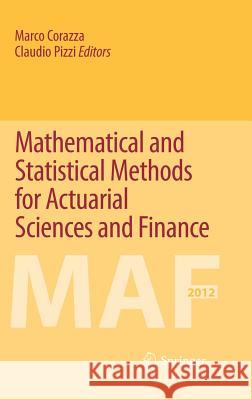Mathematical and Statistical Methods for Actuarial Sciences and Finance » książka



Mathematical and Statistical Methods for Actuarial Sciences and Finance
ISBN-13: 9783319024981 / Angielski / Twarda / 2013 / 313 str.
Mathematical and Statistical Methods for Actuarial Sciences and Finance
ISBN-13: 9783319024981 / Angielski / Twarda / 2013 / 313 str.
(netto: 461,12 VAT: 5%)
Najniższa cena z 30 dni: 462,63
ok. 22 dni roboczych
Bez gwarancji dostawy przed świętami
Darmowa dostawa!
Mathematical and Statistical Methods for Actuarial Sciences and Finance
Weak form efficiency of selected European stock markets: alternative testing approaches (G. Albano, M. La Rocca, C. Perna).- An empirical comparison of variable selection methods in competing risks model (A. Amendola, M. Restaino, L. Sensini).- A comparison between different numerical schemes for the valuation of unit-linked contracts embedding a surrender option (A.R. Bacinello, P. Millossovich, A. Montealegre).- Dynamic tracking error with shortfall control using stochastic programming (D. Barro, E. Canestrelli).- Firm’s volatility risk under microstructure noise (F. Barsotti, S. Sanfelici).- Socially responsible mutual funds: an efficiency comparison among the European countries (A. Basso, S. Funari).- Fitting financial returns distributions: a mixture normality approach (R. Bramante, D. Zappa).- Single-name concentration risk measurements in credit portfolios (R. Calabrese, F. Porro).- Bifactorial pricing models: light and shadows in correlation role (R. Cocozza, A. De Simone).- Dynamic strategies for Defined Benefit pension plans risk management (I. Colivicchi, G. Piscopo, E. Vannucci).- Particle Swarm Optimization for preference disaggregation in multicriteria credit scoring problems (M. Corazza, S. Funari, R. Gusso).- Time series clustering on lower tail dependence for portfolio selection (G. De Luca, P. Zuccolotto).- Solvency Analysis of Defined Benefit pension schemes (P. Devolder, G. Piscopo).- Stochastic actuarial valuations in double-indexed pension annuity assessment (E. Di Lorenzo, A. Orlando, M. Sibillo).- Testing for Normality when the sampled distribution is Extended Skew-Normal (C. Franceschini, N. Loperfido).- On the RODEO method for variable selection (F. Giordano, M.L. Parrella).- Portfolio allocation using Omega function: an empirical analysis (A. Hitaj, F. Martinelli, G. Zambruno).- Investment rankings via an objective measure of riskiness: a case study (M.E. Marina, M. Resta).- A squared rank assessment of the difference between US and European firm valuation ratios (M. Marozzi).- A behavioural approach to the pricing of European options (M. Nardon, P. Pianca).- Threshold structures in economic and financial time series (M. Niglio, C.D. Vitale).- Intelligent algorithms for trading the Euro-Dollar in the foreign exchange market (D. Pelusi, M. Tivegna, P. Ippoliti).- Risk management and capital allocation for Non-Life insurance companies (M. Pirra, S. Forte, M. Ialenti).- Modelling asymmetric behaviour in time series: identification through PSO (C. Pizzi, F. Parpinel).- Valuation of collateralized funds of hedge fund obligations: a Basket Option pricing approach (G.L. Tassinari, C. Corradi).- Valuation of R&D investment opportunities using the Least-Squares Monte Carlo method (G. Villani).- The determinants of interbank contagion: do patterns matter? (S. Zedda, G. Cannas, C. Galliani).
The interaction between mathematicians and statisticians has been shown to be an effective approach for dealing with actuarial, insurance and financial problems, both from an academic perspective and from an operative one. The collection of original papers presented in this volume pursues precisely this purpose. It covers a wide variety of subjects in actuarial, insurance and finance fields, all treated in the light of the successful cooperation between the above two quantitative approaches.
The papers published in this volume present theoretical and methodological contributions and their applications to real contexts. With respect to the theoretical and methodological contributions, some of the considered areas of investigation are: actuarial models; alternative testing approaches; behavioral finance; clustering techniques; coherent and non-coherent risk measures; credit scoring approaches; data envelopment analysis; dynamic stochastic programming; financial contagion models; financial ratios; intelligent financial trading systems; mixture normality approaches; Monte Carlo-based methods; multicriteria methods; nonlinear parameter estimation techniques; nonlinear threshold models; particle swarm optimization; performance measures; portfolio optimization; pricing methods for structured and non-structured derivatives; risk management; skewed distribution analysis; solvency analysis; stochastic actuarial valuation methods; variable selection models; time series analysis tools. As regards the applications, they are related to real problems associated, among the others, to: banks; collateralized fund obligations; credit portfolios; defined benefit pension plans; double-indexed pension annuities; efficient-market hypothesis; exchange markets; financial time series; firms; hedge funds; non-life insurance companies; returns distributions; socially responsible mutual funds; unit-linked contracts.
This book is aimed at academics, Ph.D. students, practitioners, professionals and researchers. But it will also be of interest to readers with some quantitative background knowledge.
1997-2025 DolnySlask.com Agencja Internetowa
KrainaKsiazek.PL - Księgarnia Internetowa









